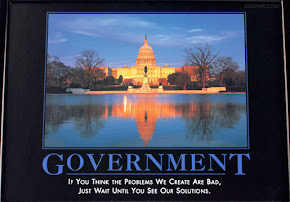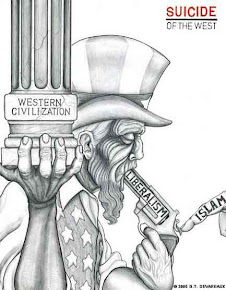Sunday, September 12, 2010
Ground Zero Mosque - A "Rabat" To Prepare For The Next Attack?
Not knowing much about "ghazva" and "rabat", I can still use my common sense to dissect what is going on. In my mind, the only reason Muslims are persisting on building at this site is that they want an "in your face" structure to commemorate their "victory" over the "great Satan".
To allow this building to be built would be disrespectful to those who died in the twin towers and would be a magnet for the terrorist cause.
Excerpt: The Prophet imposed his rule on parts of Arabia through a series of ghazvas, or razzias (the origin of the English word "raid"). The ghazva was designed to terrorize the infidels, convince them that their civilization was doomed and force them to submit to Islamic rule. Those who participated in the ghazva were known as the ghazis, or raiders.
After each ghazva, the Prophet ordered the creation of a rabat -- or a point of contact at the heart of the infidel territory raided. The rabat consisted of an area for prayer, a section for the raiders to eat and rest and facilities to train and prepare for future razzias. Later Muslim rulers used the tactic of ghazva to conquer territory in the Persian and Byzantine empires. After each raid, they built a rabat to prepare for the next razzia.
It is no coincidence that Islamists routinely use the term ghazva to describe the 9/11 attacks against New York and Washington. The terrorists who carried out the attack are referred to as ghazis or shahids (martyrs).
Thus, building a rabat close to Ground Zero would be in accordance with a tradition started by the Prophet. To all those who believe and hope that the 9/11 ghazva would lead to the destruction of the American "Great Satan," this would be of great symbolic value.
Faced with the anger of New Yorkers, the promoters of the project have started calling it the Cordoba House, echoing President Obama's assertion that it would be used to propagate "moderate" Islam.
The argument is that Cordoba, in southern Spain, was a city where followers of Islam, Christianity and Judaism lived together in peace and produced literature and philosophy.
In fact, Cordoba's history is full of stories of oppression and massacre, prompted by religious fanaticism. It is true that the Muslim rulers of Cordoba didn't force their Christian and Jewish subjects to accept Islam. However, non-Muslims could keep their faith and enjoy state protection only as dhimmis (bonded ones) by paying a poll tax in a system of religious apartheid.
If whatever peace and harmony that is supposed to have existed in Cordoba were the fruit of "Muslim rule," the subtext is that the United States would enjoy similar peace and harmony under Islamic rule.
A rabat in the heart of Manhattan would be of great symbolic value to those who want a high-profile, "in your face" projection of Islam in the infidel West.
This thirst for visibility is translated into increasingly provocative forms of hijab, notably the niqab (mask) and the burqa. The same quest mobilized hundreds of Muslims in Paris the other day to close a whole street so that they could have a Ramadan prayer in the middle of the rush hour.
One of those taking part in the demonstration told French radio that the aim was to "show we are here." "You used to be in our capitals for centuries," he said. "Now, it is our turn to be in the heart of your cities."
Before deciding whether to support or oppose the "Cordoba" project, New Yorkers should consider what it is that they would be buying.
Read the NY Post article Islam center's eerie echo of ancient terror.
To allow this building to be built would be disrespectful to those who died in the twin towers and would be a magnet for the terrorist cause.
Excerpt: The Prophet imposed his rule on parts of Arabia through a series of ghazvas, or razzias (the origin of the English word "raid"). The ghazva was designed to terrorize the infidels, convince them that their civilization was doomed and force them to submit to Islamic rule. Those who participated in the ghazva were known as the ghazis, or raiders.
After each ghazva, the Prophet ordered the creation of a rabat -- or a point of contact at the heart of the infidel territory raided. The rabat consisted of an area for prayer, a section for the raiders to eat and rest and facilities to train and prepare for future razzias. Later Muslim rulers used the tactic of ghazva to conquer territory in the Persian and Byzantine empires. After each raid, they built a rabat to prepare for the next razzia.
It is no coincidence that Islamists routinely use the term ghazva to describe the 9/11 attacks against New York and Washington. The terrorists who carried out the attack are referred to as ghazis or shahids (martyrs).
Thus, building a rabat close to Ground Zero would be in accordance with a tradition started by the Prophet. To all those who believe and hope that the 9/11 ghazva would lead to the destruction of the American "Great Satan," this would be of great symbolic value.
Faced with the anger of New Yorkers, the promoters of the project have started calling it the Cordoba House, echoing President Obama's assertion that it would be used to propagate "moderate" Islam.
The argument is that Cordoba, in southern Spain, was a city where followers of Islam, Christianity and Judaism lived together in peace and produced literature and philosophy.
In fact, Cordoba's history is full of stories of oppression and massacre, prompted by religious fanaticism. It is true that the Muslim rulers of Cordoba didn't force their Christian and Jewish subjects to accept Islam. However, non-Muslims could keep their faith and enjoy state protection only as dhimmis (bonded ones) by paying a poll tax in a system of religious apartheid.
If whatever peace and harmony that is supposed to have existed in Cordoba were the fruit of "Muslim rule," the subtext is that the United States would enjoy similar peace and harmony under Islamic rule.
A rabat in the heart of Manhattan would be of great symbolic value to those who want a high-profile, "in your face" projection of Islam in the infidel West.
This thirst for visibility is translated into increasingly provocative forms of hijab, notably the niqab (mask) and the burqa. The same quest mobilized hundreds of Muslims in Paris the other day to close a whole street so that they could have a Ramadan prayer in the middle of the rush hour.
One of those taking part in the demonstration told French radio that the aim was to "show we are here." "You used to be in our capitals for centuries," he said. "Now, it is our turn to be in the heart of your cities."
Before deciding whether to support or oppose the "Cordoba" project, New Yorkers should consider what it is that they would be buying.
Read the NY Post article Islam center's eerie echo of ancient terror.
Subscribe to:
Post Comments (Atom)






























No comments:
Post a Comment